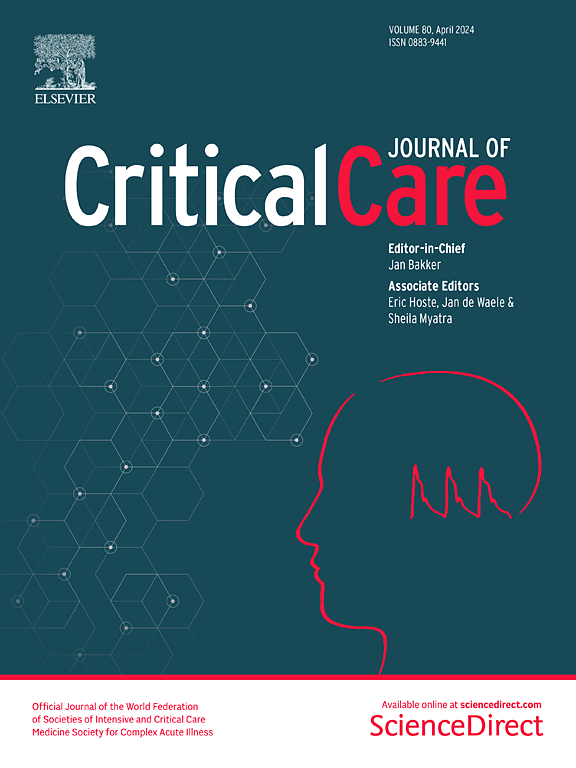重症监护室的工作量及其与危重病人预后的关系:基于登记簿的大型队列分析
IF 8.8
1区 医学
Q1 CRITICAL CARE MEDICINE
引用次数: 0
摘要
过高或过低的患者数量和工作量都可能使医护人员不堪重负,阻碍工作流程,或导致人员常规和流程不足。我们试图评估重症监护病房(ICU)当前的病例量、当前的工作量和治疗效果之间是否存在关联。对奥地利重症监护室登记数据进行了回顾性队列分析。研究纳入了2013年至2022年期间奥地利144家重症监护病房收治的年龄≥18岁患者的数据。建立了一个Cox比例危险模型,将ICU死亡率作为相关结果,并将患者各自的SAPS 3、当前ICU病例数(以ICU占用率衡量)和当前ICU工作量(以每个ICU的TISS-28中位数衡量)作为随时间变化的协变量进行调整。根据 ICU 类型、医院护理级别、COVID 前或 COVID 期间进行了分组分析。对 144 个 ICU 的 415 584 名入院患者进行了分析。与 76% 至 100% 的 ICU 病例量相比,过度使用 ICU 容量与死亡风险之间没有显著关系[HR (95% CI) 1.06 (0.99-1.15),>100% 时 p = 0.110],但对于较低的使用率[≤50% 时为 1.09 (1.02-1.16),p = 0.008,2020 年至 2022 年期间为 1.10 (1.05-1.15),p 100% 时为 1.18 (1.06-1.30),p = 0.001],即 COVID 期间,死亡风险与过度使用 ICU 容量之间没有显著关系[HR (95% CI) 1.06 (0.99-1.15),>100% 时 p = 0.110]、与参考类别的中位数相比,在 2020 年至 2022 年期间[1.18 (1.06-1.30),p = 0.001],即 COVID 期间。与 TISS-28 中位数 21-30 的参考类别相比,较低[0.88(0.78-0.99),p = 0.049(≤ 20)]的工作量与死亡风险显著相关,而不是较高。高工作量可能与当地医院较高的死亡率有关[31-40 岁为 1.09(1.01-1.19),p = 0.035;>40 岁为 1.28(1.02-1.60),p = 0.033]。在重症监护资源和强制性人员配置水平相对较高的系统中,重症监护室的高工作量一般不会影响患者的生存机会。然而,在 COVID-19 大流行等特殊情况下,如果超出计划能力,可能会导致更高的死亡风险。人员配备水平较低的小型医院重症监护室的高工作量可能与死亡风险增加有关。本文章由计算机程序翻译,如有差异,请以英文原文为准。
Intensive care unit caseload and workload and their association with outcomes in critically unwell patients: a large registry-based cohort analysis
Too high or too low patient volumes and work amounts may overwhelm health care professionals and obstruct processes or lead to inadequate personnel routine and process flow. We sought to evaluate, whether an association between current caseload, current workload, and outcomes exists in intensive care units (ICU). Retrospective cohort analysis of data from an Austrian ICU registry. Data on patients aged ≥ 18 years admitted to 144 Austrian ICUs between 2013 and 2022 were included. A Cox proportional hazards model with ICU mortality as the outcome of interest adjusted with patients’ respective SAPS 3, current ICU caseload (measured by ICU occupancy rates), and current ICU workload (measured by median TISS-28 per ICU) as time-dependent covariables was constructed. Subgroup analyses were performed for types of ICUs, hospital care level, and pre-COVID or intra-COVID period. 415 584 patient admissions to 144 ICUs were analysed. Compared to ICU caseloads of 76 to 100%, there was no significant relationship between overuse of ICU capacity and risk of death [HR (95% CI) 1.06 (0.99–1.15), p = 0.110 for > 100%], but for lower utilisation [1.09 (1.02–1.16), p = 0.008 for ≤ 50% and 1.10 (1.05–1.15), p < 0.0001 for 51–75%]. Exceptions were significant associations for caseloads > 100% between 2020 and 2022 [1.18 (1.06–1.30), p = 0.001], i.e., the intra-COVID period. Compared to the reference category of median TISS-28 21–30, lower [0.88 (0.78–0.99), p = 0.049 for ≤ 20], but not higher workloads were significantly associated with risk of death. High workload may be associated with higher mortality in local hospitals [1.09 (1.01–1.19), p = 0.035 for 31–40, 1.28 (1.02–1.60), p = 0.033 for > 40]. In a system with comparably high intensive care resources and mandatory staffing levels, patients’ survival chances are generally not affected by high intensive care unit caseload and workload. However, extraordinary circumstances, such as the COVID-19 pandemic, may lead to higher risk of death, if planned capacities are exceeded. High workload in ICUs in smaller hospitals with lower staffing levels may be associated with increased risk of death.
求助全文
通过发布文献求助,成功后即可免费获取论文全文。
去求助
来源期刊

Critical Care
医学-危重病医学
CiteScore
20.60
自引率
3.30%
发文量
348
审稿时长
1.5 months
期刊介绍:
Critical Care is an esteemed international medical journal that undergoes a rigorous peer-review process to maintain its high quality standards. Its primary objective is to enhance the healthcare services offered to critically ill patients. To achieve this, the journal focuses on gathering, exchanging, disseminating, and endorsing evidence-based information that is highly relevant to intensivists. By doing so, Critical Care seeks to provide a thorough and inclusive examination of the intensive care field.
 求助内容:
求助内容: 应助结果提醒方式:
应助结果提醒方式:


